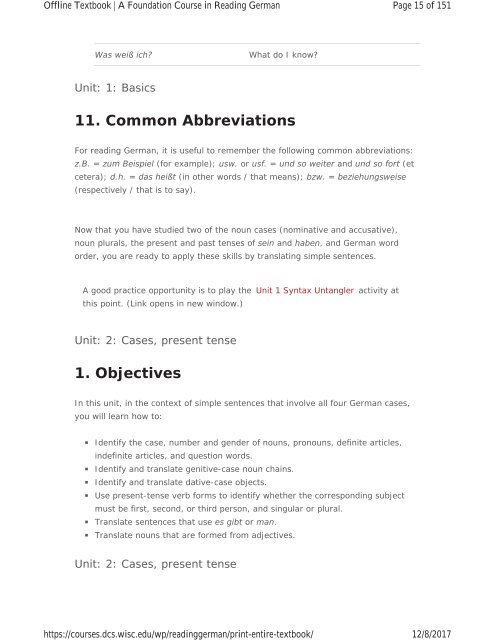A Foundation Course in Reading German, 2017a
A Foundation Course in Reading German, 2017a
A Foundation Course in Reading German, 2017a
You also want an ePaper? Increase the reach of your titles
YUMPU automatically turns print PDFs into web optimized ePapers that Google loves.
Offl<strong>in</strong>e Textbook | A <strong>Foundation</strong> <strong>Course</strong> <strong>in</strong> Read<strong>in</strong>g <strong>German</strong><br />
https://courses.dcs.wisc.edu/wp/read<strong>in</strong>ggerman/pr<strong>in</strong>t-entire-textbook/<br />
Page 15 of 151<br />
12/8/2017<br />
Was weiß ich?<br />
What do I know?<br />
Unit: 1: Basics<br />
11. Common Abbreviations<br />
For read<strong>in</strong>g <strong>German</strong>, it is useful to remember the follow<strong>in</strong>g common abbreviations:<br />
z.B. = zum Beispiel (for example); usw. or usf. = und so weiter and und so fort (et<br />
cetera); d.h. = das heißt (<strong>in</strong> other words / that means); bzw. = beziehungsweise<br />
(respectively / that is to say).<br />
Now that you have studied two of the noun cases (nom<strong>in</strong>ative and accusative),<br />
noun plurals, the present and past tenses of se<strong>in</strong> and haben, and <strong>German</strong> word<br />
order, you are ready to apply these skills by translat<strong>in</strong>g simple sentences.<br />
A good practice opportunity is to play the Unit 1 Syntax Untangler activity at<br />
this po<strong>in</strong>t. (L<strong>in</strong>k opens <strong>in</strong> new w<strong>in</strong>dow.)<br />
Unit: 2: Cases, present tense<br />
1. Objectives<br />
In this unit, <strong>in</strong> the context of simple sentences that <strong>in</strong>volve all four <strong>German</strong> cases,<br />
you will learn how to:<br />
Identify the case, number and gender of nouns, pronouns, def<strong>in</strong>ite articles,<br />
<strong>in</strong>def<strong>in</strong>ite articles, and question words.<br />
Identify and translate genitive-case noun cha<strong>in</strong>s.<br />
Identify and translate dative-case objects.<br />
Use present-tense verb forms to identify whether the correspond<strong>in</strong>g subject<br />
must be first, second, or third person, and s<strong>in</strong>gular or plural.<br />
Translate sentences that use es gibt or man.<br />
Translate nouns that are formed from adjectives.<br />
Unit: 2: Cases, present tense


















